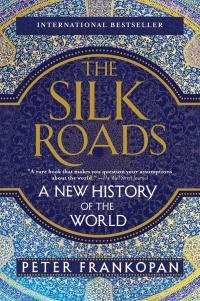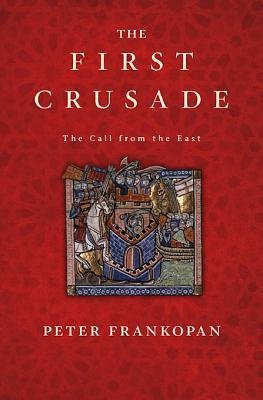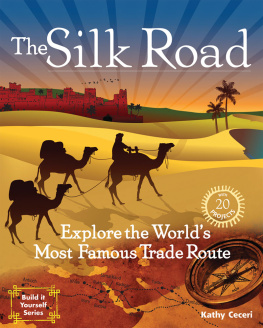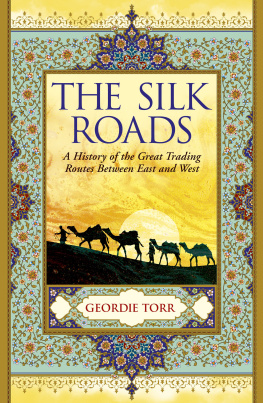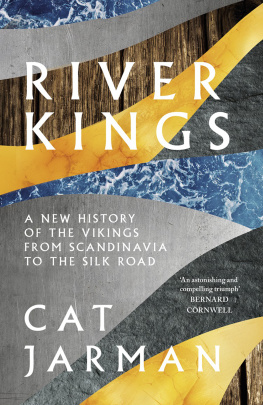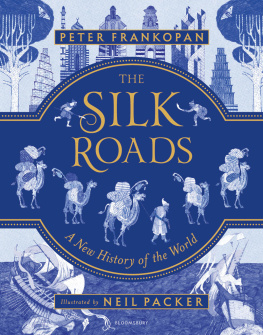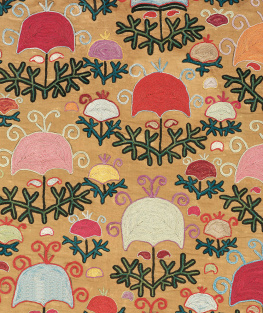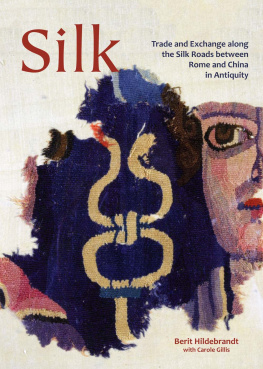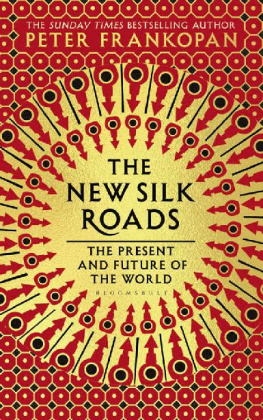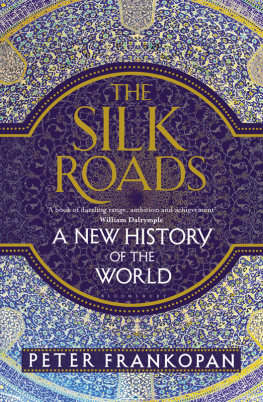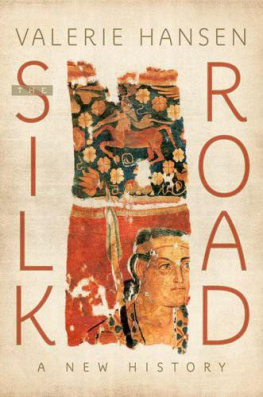Peter Frankopan
The Silk Roads: A New History of the World
To Katarina, Flora, Francis and Luke
We halted in the country of a tribe of Trkswe saw a group who worship snakes, a group who worship fish, and a group who worship cranes.
Ibn Falns Voyage to the Volga Bulghars
I, Prester John, am the lord of lords, and I surpass all the kings of the entire world in wealth, virtue and powerMilk and honey flow freely in our lands; poison can do no harm, nor do any noisy frogs croak. There are no scorpions, no serpents creeping in the grass.
Purported letter of Prester John to Rome and Constantinople, twelfth century
He has a very large palace, entirely roofed with fine gold.
Christopher Columbus research notes on the Great Khan of the East, late fifteenth century
If we do not make relatively small sacrifices, and alter our policy, in Persia now, we shall both endanger our friendship with Russia and find in a comparatively near futurea situation where our very existence as an Empire will be at stake.
Sir George Clerk to Sir Edward Grey, British Foreign Secretary, 21 July 1914
The president would win even if we sat around doing nothing.
Chief of Staff to Nursultan Nazarbayev, President of Kazakhstan, shortly before 2005 elections
Historians tend to become anxious over the issue of transliteration. In a book such as this one that draws on primary sources written in different languages, it is not possible to have a consistent rule on proper names. Names like Joo and Ivan are left in their original forms, while Fernando and Nikolai are not and become Ferdinand and Nicholas. As a matter of personal preference, I use Genghis Khan, Trotsky, Gaddafi and Teheran even though other renditions might be more accurate; on the other hand, I avoid western alternatives for Beijing and Guangzhou. Places whose names change are particularly difficult. I refer to the great city on the Bosporus as Constantinople up to the end of the First World War, at which point I switch to Istanbul; I refer to Persia until the countrys formal change of name to Iran in 1935. I ask for forbearance from the reader who demands consistency.
As a child, one of my most prized possessions was a large map of the world. It was pinned on the wall by my bed, and I would stare at it every night before I went to sleep. Before long, I had memorised the names and locations of all the countries, noting their capital cities, as well as the oceans and seas, and the rivers that flowed in to them; the names of major mountain ranges and deserts, written in urgent italics, thrilled with adventure and danger.
By the time I was a teenager, I had become uneasy about the relentlessly narrow geographic focus of my classes at school, which concentrated solely on western Europe and the United States and left most of the rest of the world untouched. We had been taught about the Romans in Britain; the Norman conquest of 1066; Henry VIII and the Tudors; the American War of Independence; Victorian industrialisation; the battle of the Somme; and the rise and fall of Nazi Germany. I would look up at my map and see huge regions of the world that had been passed over in silence.
For my fourteenth birthday my parents gave me a book by the anthropologist Eric Wolf, which really lit the tinder. The accepted and lazy history of civilisation, wrote Wolf, is one where Ancient Greece begat Rome, Rome begat Christian Europe, Christian Europe begat the Renaissance, the Renaissance the Enlightenment, the Enlightenment political democracy and the industrial revolution. Industry crossed with democracy in turn yielded the United States, embodying the rights to life, liberty and the pursuit of happiness.1 I immediately recognised that this was exactly the story that I had been told: the mantra of the political, cultural and moral triumph of the west. But this account was flawed; there were alternative ways of looking at historyones that did not involve looking at the past from the perspective of the winners of recent history.
I was hooked. It was suddenly obvious that the regions we were not being taught about had become lost, suffocated by the insistent story of the rise of Europe. I begged my father to take me to see the Hereford Mappa Mundi, which located Jerusalem as its focus and mid-point, with England and other western countries placed off to one side, all but irrelevancies. When I read about Arab geographers whose works were accompanied by charts that seemed upside down and put the Caspian Sea at its centre, I was transfixedas I was when I found out about an important medieval Turkish map in Istanbul that had at its heart a city called Balsghn, which I had never even heard of, which did not appear on any maps, and whose very location was uncertain until recently, and yet was once considered the centre of the world.2
I wanted to know more about Russia and Central Asia, about Persia and Mesopotamia. I wanted to understand the origins of Christianity when viewed from Asia; and how the Crusades looked to those living in the great cities of the Middle AgesConstantinople, Jerusalem, Baghdad and Cairo, for example; I wanted to learn about the great empires of the east, about the Mongols and their conquests; and to understand how two world wars looked when viewed not from Flanders or the eastern front, but from Afghanistan and India.
It was extraordinarily fortunate therefore that I was able to learn Russian at school, where I was taught by Dick Haddon, a brilliant man who had served in Naval Intelligence and believed that the way to understand the Russian language and dusha, or soul, was through its sparkling literature and its peasant music. I was even more fortunate when he offered to give Arabic lessons to those who were interested, introducing half a dozen of us to Islamic culture and history, and immersing us in the beauty of classical Arabic. These languages helped unlock a world waiting to be discovered, or, as I soon realised, to be rediscovered by those of us in the west.
* * *
Today, much attention is devoted to assessing the likely impact of rapid economic growth in China, where demand for luxury goods is forecast to quadruple in the next decade, or to considering social change in India, where more people have access to a mobile phone than to a flushing toilet.3 But neither offers the best vantage point to view the worlds past and its present. In fact, for millennia, it was the region lying between east and west, linking Europe with the Pacific Ocean, that was the axis on which the globe spun.
The halfway point between east and west, running broadly from the eastern shores of the Mediterranean and the Black Sea to the Himalayas, might seem an unpromising position from which to assess the world. This is a region that is now home to states that evoke the exotic and the peripheral, like Kazakhstan and Uzbekistan, Kyrgyzstan and Turkmenistan, Tajikistan and the countries of the Caucasus; it is a region associated with regimes that are unstable, violent and a threat to international security, like Afghanistan, Iran, Iraq and Syria, or ill versed in the best practices of democracy, like Russia and Azerbaijan. Overall, it appears to be a region that is home to a series of failed or failing states, led by dictators who win impossibly large majorities in national elections and whose families and friends control sprawling business interests, own vast assets and wield political power. They are places with poor records on human rights, where freedom of expression in matters of faith, conscience and sexuality is limited, and where control of the media dictates what does and what does not appear in the press.4
While such countries may seem wild to us, these are no backwaters, no obscure wastelands. In fact the bridge between east and west is the very crossroads of civilisation. Far from being on the fringe of global affairs, these countries lie at its very centreas they have done since the beginning of history. It was here that Civilisation was born, and where many believed Mankind had been createdin the Garden of Eden, planted by the Lord God with every tree that is pleasant to the sight and good for food, which was widely thought to be located in the rich fields between the Tigris and Euphrates.5

